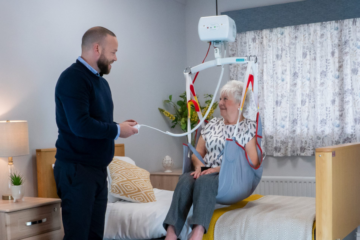Patient lifts are essential devices used to safely transfer and move patients who have mobility limitations or are unable to move independently. These devices are commonly used in hospitals, nursing homes, rehabilitation centers, and home care settings to assist caregivers in lifting, transferring, and repositioning patients. In this comprehensive guide, we will explore the different types of patient lifts, their benefits, and factors to consider when choosing the right option for your needs.
Understanding Patient Lifts
Patient lifts are assistive devices designed to help caregivers transfer patients safely and comfortably. These devices are particularly useful for patients who have limited mobility or are unable to bear weight on their own. Patient lifts are typically used to transfer patients between beds, wheelchairs, commodes, and other surfaces, as well as to assist with activities such as bathing, toileting, and repositioning.
Types of Patient Lifts:
- Manual Patient Lifts: Manual patient lifts are operated by the caregiver using hydraulic or manual pumping mechanisms to raise and lower the patient. These lifts are often less expensive than powered lifts but require more effort from the caregiver.
- Powered Patient Lifts: Powered patient lifts are operated using an electric motor or battery-powered system. These lifts are easier to operate and require less physical effort from the caregiver, making them ideal for patients who require frequent transfers or for caregivers who may have limited strength or mobility.
Benefits of Patient Lifts
Patient lifts offer several benefits for both patients and caregivers:
1. Safety:
Patient lifts help reduce the risk of injury for both patients and caregivers during transfers. By providing support and stability, patient lifts help prevent falls, strains, and other injuries that can occur during manual transfers.
2. Comfort:
Patient lifts provide a comfortable and dignified transfer experience for patients. The smooth and controlled movement of the lift helps minimize discomfort and anxiety, allowing patients to feel more secure and relaxed during transfers.
3. Independence:
Patient lifts help promote independence for patients with mobility limitations. By providing a safe and reliable means of transferring and moving, patient lifts enable patients to participate more actively in their own care and daily activities.
4. Ease of Use:
Patient lifts are designed to be user-friendly and easy to operate. With features such as intuitive controls, adjustable height settings, and ergonomic design, patient lifts help caregivers perform transfers safely and efficiently.
5. Versatility:
Patient lifts are versatile devices that can be used in a variety of settings and situations. Whether transferring patients between beds, wheelchairs, or other surfaces, patient lifts provide a reliable and flexible solution for patient transfers.
Types of Patient Lifts
Patient lifts come in a variety of styles and configurations to suit different patient needs and caregiver preferences. Some common types of patient lifts include:
1. Floor Lifts:
Floor lifts are freestanding devices that are placed directly on the floor next to the patient. These lifts feature a hydraulic or electric lifting mechanism and a sling that supports the patient during transfers. Floor lifts are ideal for patients who are unable to stand or bear weight on their own.
2. Ceiling Lifts:
Ceiling lifts are mounted to the ceiling of the room using a track system. These lifts feature a motorized lifting mechanism and a sling that attaches to the track system. Ceiling lifts are ideal for patients who require frequent transfers and for caregivers who need to transfer patients between multiple rooms.
3. Sit-to-Stand Lifts:
Sit-to-stand lifts are designed to assist patients in transitioning from a seated to a standing position. These lifts feature a sling that supports the patient’s lower body while allowing them to remain in a seated position. Sit-to-stand lifts are ideal for patients who have some weight-bearing ability but require assistance with standing.
4. Pool Lifts:
Pool lifts are specially designed to assist patients in entering and exiting swimming pools and hot tubs. These lifts feature a waterproof design and a sling that supports the patient during transfers. Pool lifts are ideal for patients who require assistance with aquatic therapy or recreational swimming.
Choosing the Right Patient Lift
When choosing a patient lift, there are several factors to consider to ensure that you select the right option for your needs:
1. Patient Needs and Abilities:
Consider the specific needs and abilities of the patient when choosing a patient lift. Assess factors such as the patient’s mobility level, weight, height, and ability to participate in transfers.
2. Caregiver Strength and Mobility:
Consider the strength and mobility of the caregiver who will be operating the patient lift. Choose a lift that is easy to operate and requires minimal physical effort from the caregiver.
3. Setting and Environment:
Consider the setting and environment where the patient lift will be used. Assess factors such as room size, layout, and accessibility to determine whether a floor lift or ceiling lift is more suitable.
4. Safety Features:
Choose a patient lift that is equipped with safety features such as emergency stop buttons, overload protection, and locking mechanisms to ensure safe and secure transfers.
5. Comfort and Accessibility:
Choose a patient lift that provides a comfortable and dignified transfer experience for the patient. Look for features such as padded slings, adjustable height settings, and ergonomic design.
6. Maintenance and Support:
Choose a patient lift from a reputable manufacturer that offers comprehensive maintenance and support services. Ensure that the lift comes with a warranty and that replacement parts and service are readily available.
Conclusion
Patient lifts are essential devices that provide safe, comfortable, and dignified transfers for patients with mobility limitations. Whether transferring patients between beds, wheelchairs, or other surfaces, patient lifts help reduce the risk of injury for both patients and caregivers and promote independence and mobility. By understanding the different types of patient lifts available, their benefits, and the factors to consider when choosing the right option, caregivers can select a patient lift that meets the specific needs of their patients and enhances the quality of care provided. With the right patient lift, caregivers can ensure safe and efficient transfers for patients and improve their overall well-being and quality of life.


